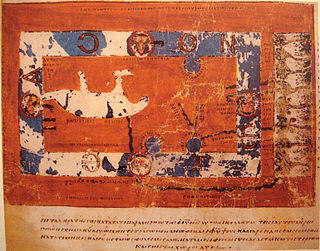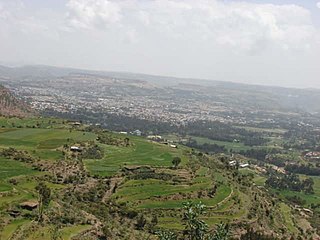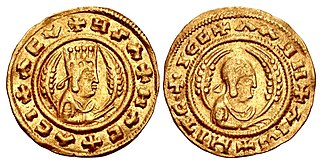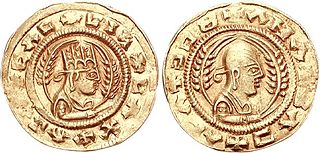Related Research Articles

Dʿmt was a kingdom located in Eritrea and northern Ethiopia which existed between the 10th and 5th centuries BC. Few inscriptions by or about this kingdom survive and very little archaeological work has taken place. As a result, it is not known whether Dʿmt ended as a civilization before the Kingdom of Aksum's early stages, evolved into the Aksumite state, or was one of the smaller states united in the Kingdom of Aksum possibly around 150 BC.
Aromata, also called the Spice Port, was an ancient seaport and emporium in the Horn of Africa, today a part of Somalia. It lay near the tip of Cape Guardafui, which was itself called the "promontory of spices". It was notable for its produce of resins and various herbs.

Adulis was an ancient city along the Red Sea in the Gulf of Zula, about 40 kilometers (25 mi) south of Massawa. Its ruins lie within the modern Eritrean city of Zula. It was the emporium considered part of the D’mt and the Kingdom of Aksum. It was close to Greece and the Byzantine Empire, with its luxury goods and trade routes. Its location can be included in the area known to the ancient Egyptians as the Land of Punt, perhaps coinciding with the locality of Wddt, recorded in the geographical list of the Eighteenth Dynasty of Egypt.

Cosmas Indicopleustes was a merchant and later hermit from Alexandria in Egypt. He was a 6th-century traveller who made several voyages to India during the reign of emperor Justinian. His work Christian Topography contained some of the earliest and most famous world maps. Cosmas was a pupil of the East Syriac Patriarch Aba I and was himself a follower of the Church of the East.

The Agaw or Agew are a Cushitic ethnic group native to the northern highlands of Ethiopia and neighboring Eritrea. They speak the Agaw languages, also known as the Central Cushitic languages, which belong to the Cushitic branch of the Afroasiatic language family, and are therefore closely related to peoples speaking other Cushitic languages.

Kaleb, also known as Saint Elesbaan, was King of Aksum, which was situated in modern-day Ethiopia and Eritrea
GDRT was a King of the Kingdom of Aksum, known for being the first king to involve Aksum in South Arabian affairs. He is known primarily from inscriptions in South Arabia that mention him and his son BYGT. GDRT is thought to be the same person as GDR, the name inscribed on a bronze wand or sceptre that was found in an area near Atsbi and Dar'a/Addi-Galamo in northern Ethiopia.

Sembrouthes was a King of the Kingdom of Aksum who most likely reigned sometime in the 3rd century. He is known only from a single inscription in Ancient Greek that was found at Dekemhare, Hamasien in modern-day Eritrea, which is dated to his 24th regnal year. Sembrouthes was the first known ruler in the lands later ruled by the Emperor of Ethiopia to adopt the title "King of Kings". He is a probable candidate for the king who erected the Monumentum Adulitanum.

Aphilas beni Dimel was a King of the Kingdom of Aksum. He is known only from the coins he minted, which are characterized by a number of experiments in imagery on the obverse, and being issued in fractions of weight that none of his successors copied.

Eon was a King of the Kingdom of Aksum. He is primarily known through the coins minted during his reign, where his name is written in Greek as "Eon Bisi Anaaph". Only his coins issued in gold are known; many new examples were identified in the al-Madhariba hoard found in Yemen.
Habesha peoples is an ethnic or pan-ethnic identifier that has been historically employed to refer to Semitic-speaking and predominantly Oriental Orthodox Christian peoples found in the highlands of Ethiopia and Eritrea between Asmara and Addis Ababa and this usage remains common today. The term is also used in varying degrees of inclusion and exclusion of other groups.

South Arabia is a historical region that consists of the southern region of the Arabian Peninsula in Western Asia, mainly centered in what is now the Republic of Yemen, yet it has also historically included Najran, Jizan, Al-Bahah, and 'Asir, which are presently in Saudi Arabia, and the Dhofar of present-day Oman.

Agame was a former province in northern Ethiopia. It includes the northeastern corner of the Ethiopian Empire, borders in Eritrea, Tembien, Kalatta Awlalo and Enderta in the south, and both the Eritrean and Ethiopian Afar lowlands in the east. This relative location of Agame is at the strategic crossroads between the Red Sea and the northern Tigrayan plateau on the other. In pre-1991, Agame had a total area of about 4,889 square kilometres (1,888 sq mi) with an estimated population of 344,800.

Aksumite currency was coinage produced and used within the Kingdom of Aksum centered in present-day Eritrea and Ethiopia. Its mintages were issued and circulated from the reign of King Endubis around AD 270 until it began its decline in the first half of the 7th century where they started using Dinar along with most parts of the Middle East. During the succeeding medieval period, Mogadishu currency, minted by the Sultanate of Mogadishu, was the most widely circulated currency in the eastern and southern parts of the Horn of Africa from the start of the 12th century.
The Monumentum Adulitanum, so named by Leo Allatius, was an ancient inscription written in Greek, depicting the military campaigns of an anonymous king. The original text was inscribed on a throne in Adulis. Although the inscription has never been discovered by archaeologists, it is known about through the copying of the inscription by Cosmas Indicopleustes, a 6th-century Greek traveler-monk. The text narrates the king's military campaigns in the African continent and in the Arabian peninsula. It is thought to be between 200 and 270 AD.
The provinces of Eritrea existed since pre-Axumite times and became administrative provinces from Eritrea's incorporation as a colony of Italy until the conversion of the provinces into administrative regions. Many of the provinces had their own local laws since the 13th century.

The Kingdom of Aksum also known as the Kingdom of Axum, or the Aksumite Empire, was a kingdom in East Africa and South Arabia from classical antiquity to the Middle Ages. Based in what is now northern Ethiopia and Eritrea, and spanning present-day Djibouti and Sudan, it extended at its height into much of South Arabia during the reign of Kaleb of Axum.
Abreha and Atsbeha were brothers and Aksumite rulers who were said to have adopted Christianity in the 4th-century, although this claim is dubious. The story of Abreha and Atsbeha is lifted from that of the historical personages King Ezana and his brother Saizana. Stuart Munro-Hay has also speculated that the myth may have emerged from a confusion with two other religious Aksumite figures: Kaleb of Axum, whose throne name was Ella Atsbeha, and Abraha, an Aksumite general who promoted Christianity in Yemen.

Somalis in Ethiopia refers to the ethnic Somalis from Ethiopia, particularly the Ogaden, officially known as the Somali Region. Their language is primarily Somali and are predominantly Muslim. According to a 2017 census from the Central Statistical Authority, the Somalis were the third largest ethnic group in Ethiopia with roughly 11,000,000 people accounting for 8.2% of the country’s population, after Oromo (34.4%) and Amhara (27%). The Somali population in Ethiopia make up around 30-40% of the total Somali population worldwide.

In antiquity, the ancestors of the Somali people were an important link in the Horn of Africa connecting the region's commerce with the rest of the ancient world. Somali sailors and merchants were the main suppliers of frankincense, myrrh and spices, items which were considered valuable luxuries by the Ancient Egyptians, Phoenicians, Mycenaeans and Babylonians. During the classical era, several ancient city-states competed with the Sabaeans, Parthians and Axumites for the wealthy Indo-Greco-Roman trade.
References
- ↑ Hatke, George (2013-01-07), "3. The Third Century CE: Monumentum Adulitanum II (RIE 277)", 3. The Third Century CE: Monumentum Adulitanum II (RIE 277), New York University Press, pp. 37–66, ISBN 978-0-8147-6278-3
- 1 2 Stuart Munro-Hay, Aksum: An African Civilization of Late Antiquity (Edinburgh University Press, 1991), p. 187.
- 1 2 Munro-Hay, Ethiopia, the Unknown Land: A Cultural and Historical Guide (I. B. Tauris, 2003), p. 235.
- ↑ Y. Shitomi (1997), "A New Interpretation of the Monumentum Adulitanum", Memoirs of the Research Department of the Toyo Bunko55, 81–102.
- ↑ McCrindle 2010, p. 63.
- ↑ William, Vincent (1800). The Periplus of the Erythrean Sea, Volume 1. p. 65.
- ↑ al-Riyāḍ, Jāmiʻat (1979). Sources for the History of Arabia. p. 95.
- ↑ L. P. Kirwan (1972), "The Christian Topography and the Kingdom of Axum", The Geographical Journal, 138(2), p. 174. doi : 10.2307/1795960
- 1 2 Guest Tomlins, Frederick (1844). A Universal History of the Nations of Antiquity. p. 846.
- ↑ Wayessa, Bula Sirika. "Toward a history of the Oromo of Wallaga in southwestern Ethiopia: an ethnoarchaeological study of ceramic technological style and tuber crop domestication." (2016).
- ↑ Tindel, Raymond D. "Archaeological Survey of Yemen: The First Season." Current Anthropology 21.1 (1980): 101-102.
- ↑ Martin, E. G. "MAHDISM AND HOLY WARS IN ETHIOPIA BEFORE 1600." Proceedings of the Seminar for Arabian Studies. Seminar for Arabian Studies, 1974.
- ↑ Maqrizi p 17.
- ↑ Society, Royal Geographical. Supplementary Papers Page. p. 551.
They called the people " Harli," and said they were there prior to the Gallas. The latter had dug the rocky wells at Kirrid which we saw on first entering the country, and had cut a rude Christian cross in the face of the cave—■ the only ancient sign existing of a rude form of Christianity in the land